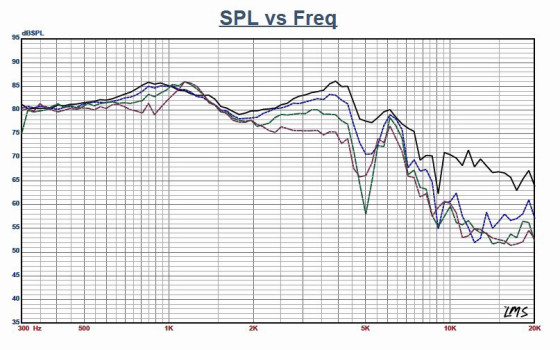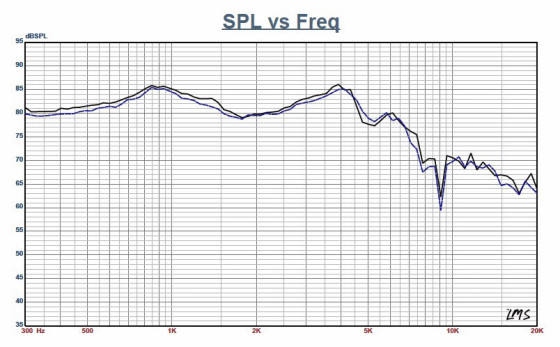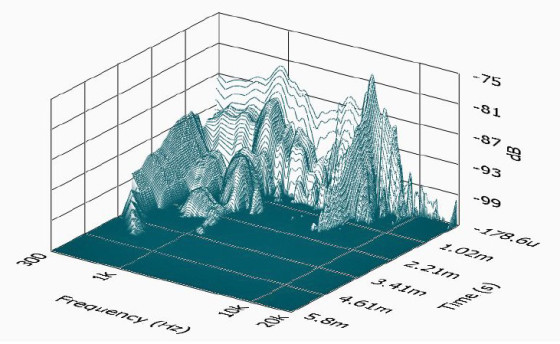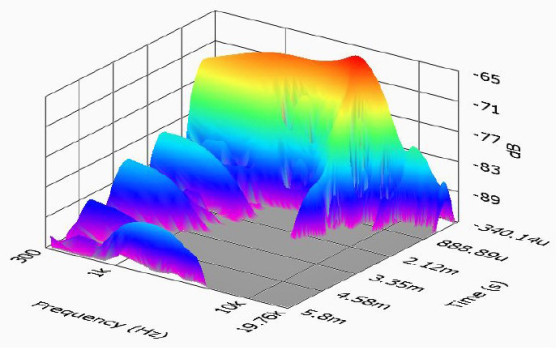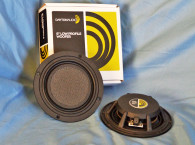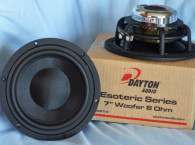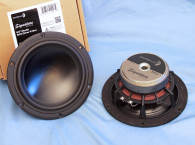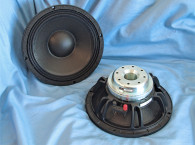The ES140Ti-8 5.5” midwoofer is another model from Dayton Audio’s new Esoteric line. The 5.5” ES140Ti-8 is the companion model to the Dayton Audio Esoteric 7” ES180Ti-8 midwoofer, which was featured in Voice Coil’s December 2014 issue. Features for the ES-140Ti are similar to the ES-180Ti and include a well configured proprietary six-spoke cast-aluminum frame with narrow 9-mm wide spokes to minimize reflections back into the cone (see Photo 1).
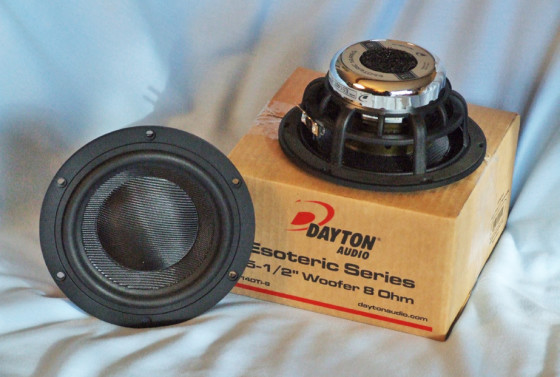
The area below the suspended spider mounting shelf is almost completely open, resulting in effective cooling of the motor and voice coil. For the cone assembly, Dayton Audio chose a rather stiff flat-profile woven glass fiber cone with a 2.75” diameter convex woven glass fiber dust cap. Compliance is provided by a nitrilebutadiene rubber (NBR) surround, nicely designed with a shallow discontinuity where it attaches to the cone edge.
Remaining compliance comes from a 4.5” diameter elevated black cloth spider. The Dayton Audio ES140Ti-8’s motor design is well thought out and incorporates dual copper shorting rings (Faraday shields) and a neodymium ring magnet. Finite Element Analysis (FEA) designed, the neodymium magnet motor uses a 3” (76-mm) diameter voice coil wound with rectangular copper-coated aluminum wire (CCAW) on a titanium former (hence the ES140Ti designation). Motor parts include a polished chrome return cup for the neodymium ring magnet that incorporates a 35-mm diameter rear vent (with an open-cell foam dust cover) for additional cooling. Last, the voice coil is terminated to a pair of gold-plated terminals. In terms of physical appearance, this is a very good-looking driver.
I used the LinearX LMS analyzer and VIBox to create voltage and admittance (current) curves with the driver clamped to a rigid test fixture in free air at 0.3, 1, 3, 6, and 10 V. Unlike a majority of 5.25” to 5.5” diameter woofers, 10-V curves are usually too nonlinear for LEAP to get a reasonable curve fit.
However, that was not the case for the ES140Ti-8. I was able to use all the curves including the 10-V curves. As has become the protocol for Test Bench testing, I no longer use a single added mass measurement to determine VAS. I use the actual measured cone assembly mass (Mmd) supplied by the driver manufacturer, which was 16.5 grams for the Dayton 5.5” woofer.
Next, I post processed the 10 550-point stepped sine wave sweeps for each ES140Ti sample and divided the voltage curves by the current curves (admittance) to derive impedance curves, phase added by the LMS calculation method. I imported them, along with the accompanying voltage curves, to the LEAP 5 Enclosure Shop software.

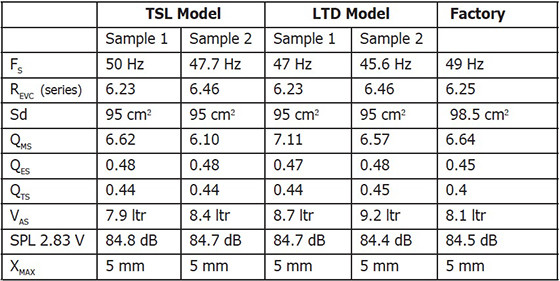
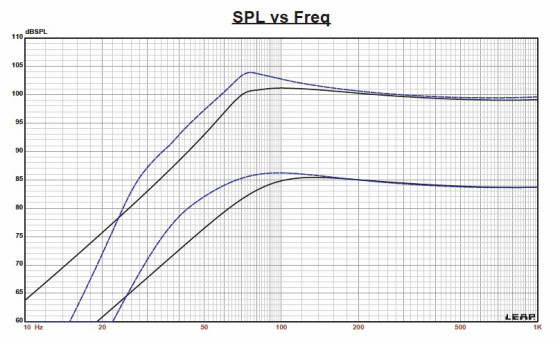
Since most Thiele-Small (T-S) data provided by the majority of OEM manufacturers is generated using the standard model or the LEAP 4 TSL model, I used 1-V free-air curves to additionally create a LEAP 4 TSL parameter set. I selected the complete data set, the LTD model’s multiple voltage impedance curves, and the TSL model’s 1-V impedance curve in the LEAP 5‘s transducer derivation menu and created the parameters for the computer box simulations. Figure 1 shows the 1-V free-air impedance curve. Table 1 compares the LEAP 5 LTD, TSL, and factory published parameters for both Dayton Audio ES140Ti-8 samples.
LEAP parameter calculation results for the ES140Ti-8 were, as with the ES180Ti last month, very close to the published factory data. Following my normal protocol for Test Bench testing, I used the LEAP LTD parameters for Sample 1 to set up computer enclosure simulations. I programmed two computer box simulations in LEAP 5—a Butterworth-type sealed enclosure with a 278 in3 volume with 50% fiberglass fill material and a vented QB3 with a 503 in3 volume tuned to 44 Hz with 15% fiberglass damping material.
Figure 2 shows the ES140Ti-8’s results in the vented and sealed boxes at 2.83 V and at a voltage level sufficiently high enough to increase cone excursion to 5.75 mm (XMAX + 15%). This produced a F3 frequency of 74 Hz (F6 = 60.2 Hz) with a QTC = 0.68 for the Butterworth sealed enclosure and –3 dB = 55 Hz (F6 = 43.8 Hz) for the vented QB3 alignment.

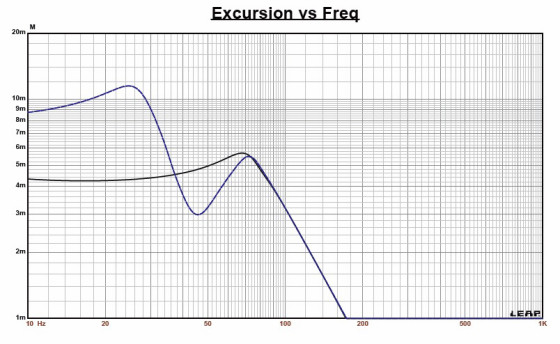
Increasing the voltage input to the simulations until the maximum linear cone excursion was reached resulted in 101 dB at 19.5 V for the closed-box enclosure simulation and 104 dB for a 21-V input level for the larger vented box. Figure 3 shows the 2.83-V group delay curves. Figure 4 shows the 19.5/21-V excursion curves. Because the vented box example reached 11 mm of excursion at about 25 Hz (twice the XMAX number), adding a steep 24 dB/octave high-pass active filter located about 25 to 30 Hz would prevent over excursion and distortion for vented box example by a substantial margin.
Klippel analysis for the ES140Ti-8 produced the Bl(X), KMS(X), and Bl and KMS symmetry range plots shown in Figures 5–8. (Our analyzer is provided courtesy of Klippel GmbH. Pat Turnmire, of Redrock Acoustics, performs the tests. This data is extremely valuable for transducer engineering, so if you don’t own a Klippel analyzer and want analysis done on a particular project, visit www.redrockacoustics.com)
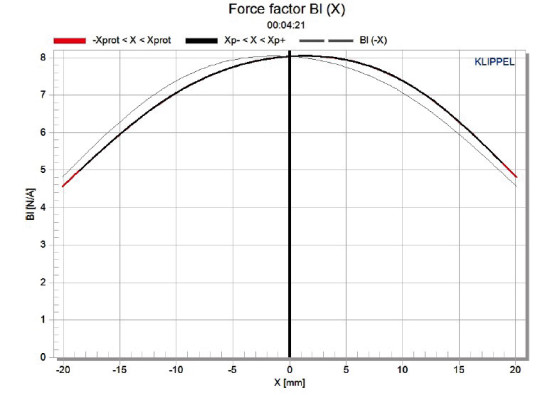
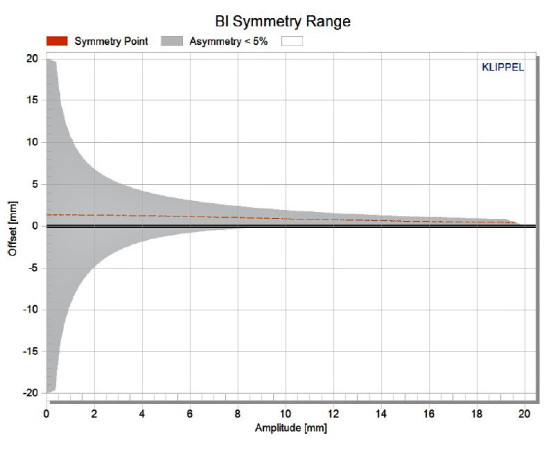
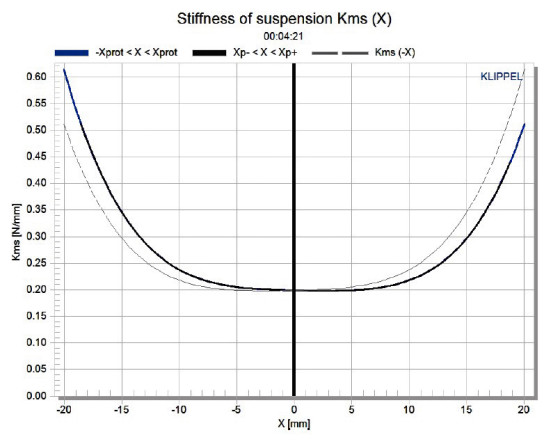
The ES140Ti-8’s Bl(X) curve is very symmetrical and has a rather broad Bl curve for a 5.5” woofer (see Figure 5). The Bl symmetry plot shows a fairly constant coil-out offset that reaches about 1.2 mm at the driver’s physical XMAX position, which is trivial and probably within production tolerance (see Figure 6).
Figure 7 and Figure 8 show the ES140Ti-8’s KMS(X) and KMS symmetry range curves. The KMS(X) curve is definitely not as symmetrical in both directions as the Bl curve, but it shows a decreasing coil-out offset that gets to about 0.62 mm at the physical XMAX position, which is also relatively minor.
The ES140Ti-8’s displacement limiting numbers were XBl at 82% (Bl = 12.4 mm) and for XC at 75%, CMS minimum was 11.9 mm, which means the compliance is the most limiting factor for prescribed distortion level of 10%. However, both numbers were significantly greater than this driver’s physical XMAX.
Figure 9 shows the ES140Ti-8’s inductance curves Le(X). Inductance will typically increase in the rear direction from the zero rest position as the voice coil covers more pole area. However, this does not occur because of the effective multiple copper inductive shorting rings. The result is a minor inductance swing with an inductive variation of 0.03 to 0.05 mH from the resting position to the in and out XMAX positions, which is good performance in any driver.
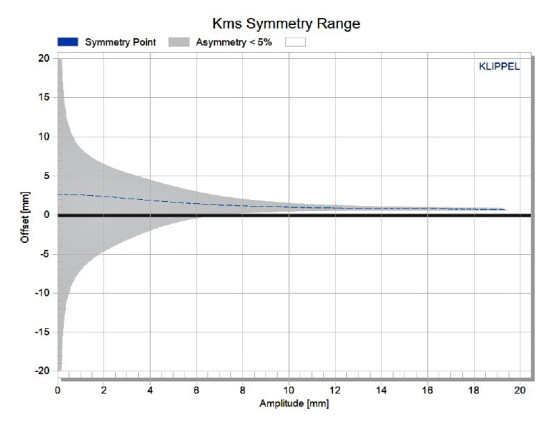
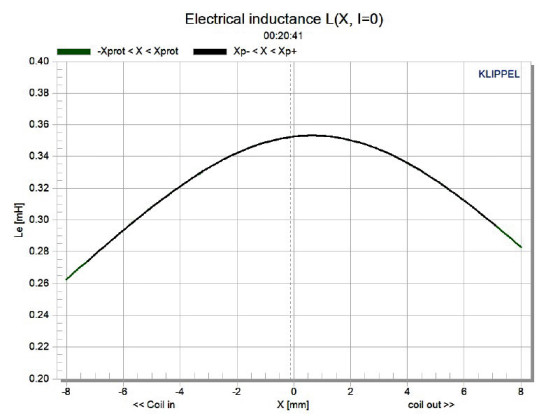
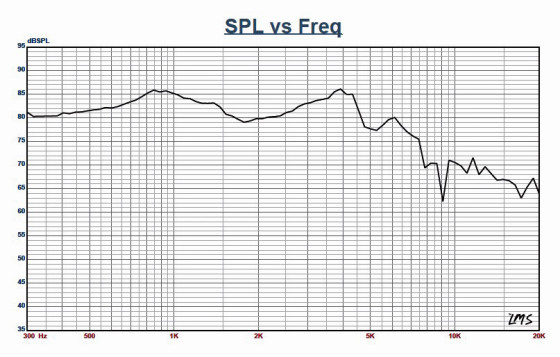
Following the Klippel testing, I mounted the ES140Ti-8 woofer in an enclosure with a 15”× 8” baffle filled with damping material (foam). Then, I used the LinearX LMS analyzer set to a 100-point gated sine wave sweep to measure the device under test (DUT) on and off axis from a 300-Hz-to-40-kHz frequency response at 2.83 V/1 m.
Figure 10 shows the ES140Ti-8’s on-axis response indicating a smoothly rising response to about 900 Hz, dropping about 6 dB to 2 kHz, and rising again to about 4 kHz, where it begins its low-pass roll-off. Figure 11 displays the on- and off-axis frequency response at 0°, 15°, 30°, and 45°. The –3 dB frequency at 30° off axis relative to the on-axis sound pressure level (SPL) is about 2.8 kHz, suggesting a crossover between 2 to 3 kHz should be appropriate. Figure 12 provides the ES140Ti-8’s two-sample SPL comparisons, showing a 0.5-to-1-dB match throughout the operating range up to 4 kHz.
For the remaining tests, I used the Listen SoundCheck software, SoundConnext analyzer, and SCM microphone (courtesy of Listen) to measure distortion and generate time-frequency plots. For the distortion measurement, I mounted the ES140Ti-8 in free air and used the noise stimulus to set the SPL to 94 dB at 1 m (12.6 V). Then, I measured the distortion with the Listen microphone placed 10 cm from the dust cap.
Figure 13 shows the distortion curves. I then used SoundCheck to get a 2.83-V/1-m impulse response and imported the data into Listen’s SoundMap Time/Frequency software. Figure 14 shows the resulting cumulative spectral decay (CSD) waterfall plot. Figure 15 shows the Wigner-Ville (for its better low-frequency performance) plot.
www.daytonaudio.com
